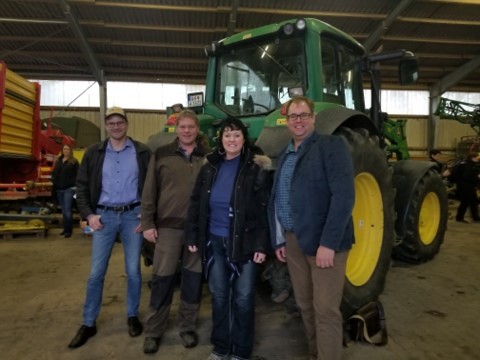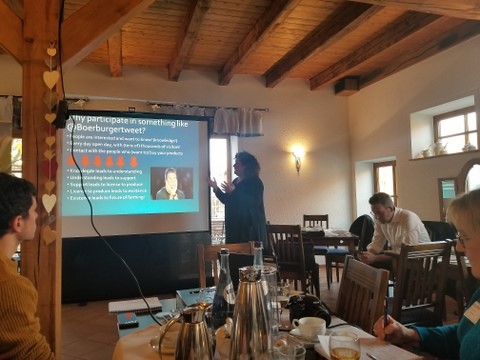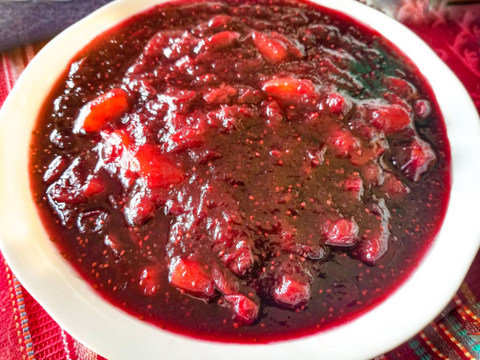Farm Life Journal - December 2018
December 9, 2018
By Darcy Dougherty Maulsby
Holiday greetings from Calhoun County!
Where has the year gone? This will be my last Farm Life Journal for 2018. It has been a pleasure to give you an insider’s view of what goes on at an Iowa farm throughout the year.
Our crops are harvested, and snow now covers the ground here in Calhoun County, but boy, have things been busy. Here’s what’s been going on around the farm this month:
Planning for the 2019 crop. We’re going to keep our crop rotation 50/50, meaning half of our acres will be corn and half will be soybeans. We recently met with Rick, our agronomist from the local cooperative. We’ve worked with him for years, so he knows our land. After looking at our soil tests to see how many nutrients are in the soil, we worked together to develop a fertilizer plan for the 2019 crop. Our goal? Feed the plants properly, but don’t over-fertilize since we want to protect the environment.
 Decorating for Christmas. Every year my family goes to the local John Deere dealership to get the latest Deere commemorative Christmas ornament. I'm thrilled to see that this year's ornament honors the 100th anniversary of the iconic Waterloo Boy tractor. It’s hard to imagine a time when John Deere wasn’t a powerhouse in the tractor business. Yet, Deere wouldn’t enter the farm tractor business until March 1918 through the acquisition of the Waterloo Gasoline Engine Company – a milestone so noteworthy that the Waterloo Boy was carved in butter at the 2018 Iowa State Fair. Read my coverage of the fascinating story. Please note, by clicking the following links, you’ll be leaving a partially funded checkoff site.
Decorating for Christmas. Every year my family goes to the local John Deere dealership to get the latest Deere commemorative Christmas ornament. I'm thrilled to see that this year's ornament honors the 100th anniversary of the iconic Waterloo Boy tractor. It’s hard to imagine a time when John Deere wasn’t a powerhouse in the tractor business. Yet, Deere wouldn’t enter the farm tractor business until March 1918 through the acquisition of the Waterloo Gasoline Engine Company – a milestone so noteworthy that the Waterloo Boy was carved in butter at the 2018 Iowa State Fair. Read my coverage of the fascinating story. Please note, by clicking the following links, you’ll be leaving a partially funded checkoff site.
Working on my upcoming book. I was reminded some things never change as I researched my upcoming book, “Iowa Agriculture: A History of Farming, Food and Family." The History Press will publish the book in 2019. "We were hauling out manure all day, and it was a disagreeable job," wrote Godfrey Lenocker in his diary on Oct. 7, 1870. Lenocker moved to Madison County in 1869 from Illinois and bought 320 acres of virgin prairie near Dexter for $2 an acre. For years, Lenocker kept a diary of daily life on the farm. That invaluable historical record is now in the care of Lenocker's great-great grandson, Ted Lenocker, whose family still lives in Madison County. They shared the diary with me and have been gracious to let me share their story. Turns out my cat Lieutenant Dan, who was sitting on my lap as I did my research, is wild about history. OK, maybe not. He just started ripping my bookmark apart with his teeth.
Showcasing rural Iowa. Why do I love rural? Big dreams can take root in small towns, especially if there's a barn involved. Just ask my friend Lynn Dobson of Lake City, whose amazing Dobson Pipe Organ Builders business was featured on Des Moines' WHO TV Channel 13 News in November on the segment "From Lake City to New York City." I've had the chance to interview Lynn and his team through the years, and one of my favorite facts about this home-grown success story focuses on the barn on the farm southeast of Lanesboro where Lynn grew up. “Barns are grand buildings, and I’m inspired by their magnificent spaces,” Lynn told me. “They feel like cathedrals inside.” Get the rest of the story here.
Traveling the world to speak up for agriculture. I had a once-in-a-life opportunity to travel from Yetter to northern Germany to tour farms and visit icons like the Brandenburg Gate in Berlin in mid-November. I joined about 15 other ag professionals from the Midwest for the Transatlantic Agricultural Dialogue on Consumer Engagement, which was coordinated by the German-American Chamber of Commerce. We visited with other farmers and ag professionals from Germany and the Netherlands who also share ag’s stories through social media. We met with representatives from the U.S. Department of Agriculture's (USDA) Foreign Agricultural Service to discuss trade policy and more.



Pop quiz! What are the top U.S. ag exports to Germany? Soybeans and pistachios.
We also toured a German dairy farm and swine farm. And can you guess what German pigs eat? Beer and pretzels… sort of! When our group met German hog farmer Henning Kocher, he explained that his feed rations include pretzel dough, potatoes and spent grain from beer breweries. A truck from a brewery brought a delivery when we were at the farm. Liquid is added to the pretzel dough and the mixture is heated to kill the yeast. All the other ingredients, including corn silage (yes, really!), vitamins, minerals and amino acids are added to the feed, which is like pig porridge. Quite a bit different than how we do things in Iowa, but it seems to make sense in Germany.
While in Hanover we visited EuroTier, one of the largest farm trade shows in Europe. The event showcases the latest technology to support more productive, sustainable farming practices that promote animal well-being. We also visited a family farm about an hour from Hanover that grows potatoes, broccoli, cauliflower, winter wheat and other crops. They also raise horses, run an on-farm restaurant and operate on-farm grocery store with beautiful fresh produce, including the biggest onions, rutabagas, and parsnips I've ever seen.
Even though these European farmers grow different crops than we do on my family’s farm, I was amazed at how many things we have in common when it comes to our goal of sharing ag’s story.
It has been fun to share my stories with you this year. Thanks for being part of the Iowa Food & Family Project.
Wishing you a Happy New Year!
Darcy
Brandied Cranberry Apricot Relish
If you're tired of boring cranberry sauce, try this relish! I make it each year for Thanksgiving and Christmas on the farm. I love the way the cranberries and apricots play off each other, and it's fun to hear the cranberries pop in the saucepan. Plus, a hit of brandy makes a humble side dish much more memorable, don't you think?
 3/4 cup apricot, apple or other fruit juice
3/4 cup apricot, apple or other fruit juice- 3/4 cup granulated sugar
- 1/2 cup thinly sliced dried apricots* (or 1 can of apricots)
- 1/2 teaspoon cinnamon
- 1/4 teaspoon allspice
- 1 bag (12 ounces) fresh cranberries (about 3 cups)
- 2 tablespoons brandy (I like cherry brandy)
In saucepan combine fruit juice, sugar, dried apricots, cinnamon and allspice. (*Note: Dried apricots are not always easy to find in my rural area, so if I don't stock up ahead of time, I just get canned apricots at the local grocery store. I drain the juice and substitute it for the fruit juice this recipe calls for. I also cut up the apricot slices and add them at the end of the cooking process, along with the brandy.)
Heat mixture to boiling over medium-high heat, stirring occasionally. Stir in cranberries; return to boiling. Reduce heat to medium-low; cook 12-14 minutes, or until most cranberries burst. Stir occasionally.
Remove saucepan from heat. Add brandy, if desired, and apricots (if you opted for canned apricots). Allow relish to cool slightly before pouring it into serving bowl. Cover and refrigerate for several hours, or up to 4 days. Makes about 2 1/2 cups.